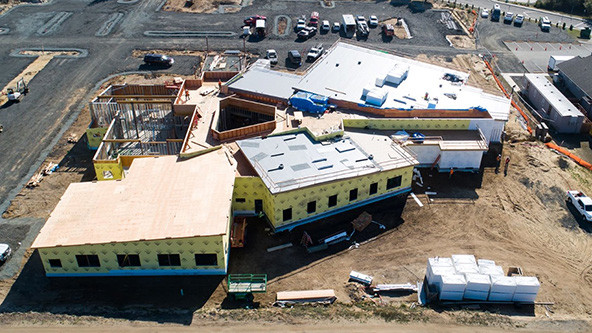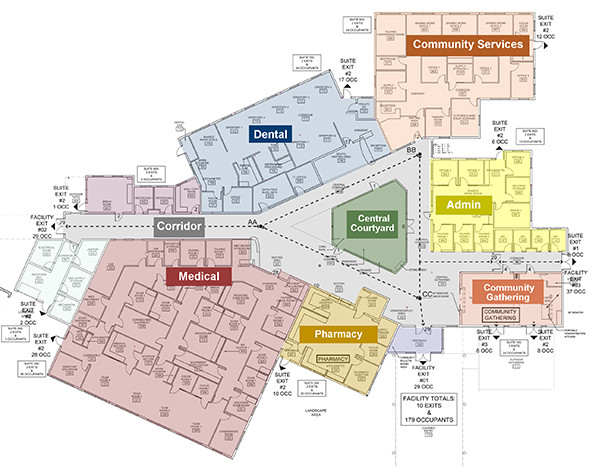 (Photo courtesy of Coquille Indian Tribe)
(Photo courtesy of Coquille Indian Tribe)
In late December 2020, amidst a tumultuous US presidential transition and raging COVID-19 pandemic, the US House and Senate passed the Consolidated Appropriations Act, an annual constitutional obligation that funds the government (and prevents a shutdown). This time, however, the bill reached further than its constitutional requirements. In addition to $900 billion in COVID-19 stimulus funding, it included a five-year, $25 billion extension of the New Markets Tax Credit (NMTC) program for America’s at-risk communities, the largest extension in the history of the program.
Invented as part of a broader set of “third way” reforms under the Clinton administration, NMTCs are aimed at improving conditions in low-income communities via market-friendly policies. Managed by the Treasury, NMTCs enable private investors to purchase tax credits for their development work in low-income communities, with the net sale proceeds funding projects that deliver better jobs, buildings, schools, and health outcomes. And from the perspective of most analysts, the now 20-year-old program is a resounding success, receiving rare bipartisan support in Congress for generating investment across all 50 states, the District of Columbia, and Puerto Rico. More than $60 billion in tax credits have been utilized in America since the inception of the program, creating more than 1 million jobs and generating $8 of private capital for every $1 of NMTC investment.
The program is not without its detractors, of course. Some researchers have suggested that NMTCs are the sort of subsidized investment that may deliver only modest positive effects on neighborhood conditions; for example, the program might incentivize the building of a new supermarket, but that might not impact actual household food purchasing patterns, at least in the short term. Yet if the program’s critics argue that the gains are only modest and moderate, analysts do agree that NMTCs provide distressed communities an economic opportunity that didn’t exist before 2000. Whether large or small, those community gains exist.
Outsized Impact on the Oregon Coast
An example of the NMTC’s large potential for impact is the Coquille Indian Tribe, which continues to utilize the program to help correct more than 150 years of historical wrongs.
Are you enjoying this article? Read more like this, plus SSIR's full archive of content, when you subscribe.
Along with most of Oregon’s coastal tribes, the Coquille signed the 1855 Coast Treaties, which forced them to move to the Coast Indian Reservation, now known as the Siletz Reservation. Between the 1860s and 1880s, as federal policies reduced the reservation’s size, the Coquille were displaced again, essentially sent back to homes that no longer existed. When congress “terminated” the Coquille’s federal status in 1954, thereby extinguishing all remaining vestiges of those long-ago treaties.
In 1989, however, after three decades of official non-existence, tribal leaders’ bold and persistent efforts persuaded Congress to restore federal recognition. This restoration made the Coquille people once again eligible for federal programs and services, but it didn’t provide land or resources with which to build a tribal economy. Achieving economic success and governmental self-sufficiency was left to the Coquille people.
As the tribe worked to build their economic future, in 2005 they turned to regional nonprofit Craft3, a certified Community Development Financial Institution under the NMTC program, for a tax credit allocation in support of the construction of The Mill Casino, a hotel and RV park on the site of a former sawmill. Support from Craft3 and other private investors helped the tribal enterprise flourish and generate family-wage jobs that continue to this day.
The Mill Casino’s financial success allowed the tribe to think more broadly and flexibly about the next steps toward fiscal and cultural self-determination. The tribal leadership once again turned to Craft3 and other investors in 2015 for NMTCs to acquire the 3,200-acre Sek-wet-se Forest, with the goal of creating jobs by sustainably managing the forestland. Considered part of their ancestral homeland, this forestland contributes to the tribe’s long-term vision for economic self-sufficiency and cultural revitalization. Altogether, the tribe now owns more than 10,000 acres of sustainably managed forestland, a step that likely wasn’t possible without the federal NMTC program. Three decades after restoration, the Coquille Indian Tribe has become Coos County’s second-largest employer and an important contributor to the southern Oregon Coast’s social, political, and cultural vitality.
 (Photo courtesy of Coquille Indian Tribe)
(Photo courtesy of Coquille Indian Tribe)
In 2020, the tribe once again utilized NTMCs to begin development of the Ko-Kwel Wellness Center (the historical pronunciation of the tribe’s name), a 22,000-square-foot facility that is due to open in 2021. When complete, the new center will nearly triple the Coquille Tribe’s existing health-care space and offer primary health care, dentistry, a pharmacy, and behavioral health, potentially adding chiropractic, massage, acupuncture, and other services in the future – all under one roof.
According to tribal chief Don Ivy, this project simply wouldn’t exist without NMTCs. “We couldn’t just write a check,” he says. “The tax credits gave us the foundation of funding; it was the platform for success.”
“Craft3’s entire reason for being is to deliver hard-to-find capital to the most meaningful projects in Pacific Northwest communities,” said Craft3 President and CEO Adam Zimmerman. “When we are honored with long-term partnerships like this one with the Coquille Indian Tribe, and persistent enough to attract scarce NMTC resources to our region, so much good becomes possible.”
With Craft3’s commitment to allocate NMTCs to the project, Wells Fargo stepped forward to purchase the tax credits, with the net proceeds going to the construction of the new facility. Craft3 and Coastal Enterprises Inc. provided additional loans for the innovative $12 million financing package, which also included support from the US Economic Development Administration, Meyer Memorial Trust, the Indian Health Service, the Northwest Area Foundation, and others.
Kilkich, the tribe’s modern “reservation village” of beautiful homes and tribal offices where windswept juniper fills the air and the Coos River meets the Pacific Ocean, is the site of the future Ko-Kwel Wellness Center. According to Tribal Chairman Brenda Meade, the building is designed to have tribal members feel welcomed in a setting that celebrates their history, and according to Chief Ivy the new facility delivers something the tribe has needed for generations: A home for healing.
A Future of Community Renewal and Recovery
Today, with America besieged by simultaneous economic, health, culture, and climate crises, the economic frailty of the country’s underserved communities has never been more apparent. The five-year reauthorization of the federal NTMC program provides a glimmer of hope to move distressed communities forward. In Indian Country alone, which has been hit especially hard by COVID-19 and current recession, the program will ease regulatory roadblocks and drive the creation a variety of new health care facilities, amongst other projects. In cities and towns in all 50 states and territories, it’s estimated that the $25 billion in additional NMTC allocation will catalyze at least 275 mixed-use projects (combining housing, commercial, and social services); 255 new or improved health clinics, hospitals, and medical offices; and 775 investments in daycare centers, Boys and Girls Clubs, and other community facilities. Overall, the program seeks to create 600,000 new jobs by 2025.
As the confluence of current crises continues to envelop the country, NMTCs will play a critical role in ensuring that America’s rural and underserved communities—and everywhere in between—are not left behind. According to the national New Markets Tax Credits Coalition, the renewal provides the “patient capital” needed to rebuild and grow.
Today in America, there exists no other federal tax incentive as generally available as NMTCs to promote economic revitalization in rural and distressed census tracts. NTMC financing supports low-income communities, and 80 percent goes to the poorest places in America, far exceeding statutory requirements. Communities have come to count on the NMTC as a source of low-cost capital for challenging projects that would not be possible but-for NMTCs, according to NMTC Coalition President Yvette Ittu, the President of Cleveland Development Advisors.
“Since its inception, the New Markets Tax Credit has delivered well over $105 billion in flexible capital to towns and neighborhoods left outside the economic mainstream,” she says. “During this difficult time for many communities that were already struggling, the NMTC provides a tremendous opportunity to create jobs, increase opportunity and help put America back on a solid financial footing.”
Support SSIR’s coverage of cross-sector solutions to global challenges.
Help us further the reach of innovative ideas. Donate today.
Read more stories by Seth Walker.

